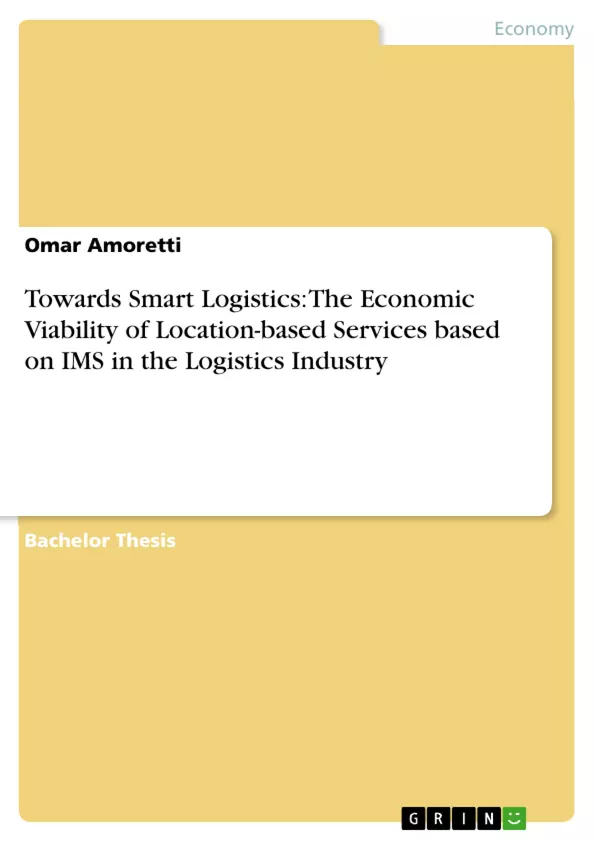Smart Logistics represent technologies that enable fuel reduction and energy efficiency through better route and load planning. Within this context, location-based services (LBS) are an enabler for Smart Logistics by bringing location information to existing mobile applications. For instance, this creates a great deal of value-added, personalized services aimed at meeting enterprise as well as user demands for improved safety and efficiency.
This thesis should examine the economic feasibility of future implementations of LBS in the European logistics industry, especially for on-road transportation services. Furthermore, the ongoing evolution of mobile communication standards (4G, LTE) along with the IP Multimedia Subsystem (IMS) surely boost the realization of yet unexploited opportunities in the logistics industry: cost-effective and smart tracking systems with global reach tailored at specific (logistical) needs may serve as example.
In fact, this could benefit not only the direct parties involved (logistics providers and their customers), but also other stakeholders like communities in terms of a reduced environmental impact, etc. The IMS, an architectural framework for the delivery of IP multimedia services, is capable to offer real-time LBS to foster the transition to Smart Logistics.
From this point of view, the technological readiness of telecom operators as service providers plays an important role while assessing the economic feasibility of LBS in the logistics industry. Here, the term economic feasibility refers to savings (e.g. fuel savings over implementation costs) derived from the usage and maintenance of devices supporting LBS within the IMS architectural framework.
The thesis takes these aspects into consideration in order to evaluate advantages, drawbacks and risks derived from the provision of LBS.
Inhaltsverzeichnis (Table of Contents)
- Introduction
- Thesis Structure
- Background Information
- LBS and Smart Logistics
- Motivation within the Logistics Industry
- Motivations for Telco Operators and LBS Providers
- Understanding the Context
- IMS: The Enabling Architectural Framework
- The Role of ICT in Favour of Smart Logistics
- Current Challenges and Key Drivers in the Logistics Industry
- Smart Logistics based on ICT
- Towards Smart Logistics: the LBS Approach Based on IMS
- How it Works: The Logistics Provider's Perspective
- Implications for Telecom Operators and LBS Providers
- Intelligent Network (IN) Limitations
- Issues on Private Data Security
- LBS Based on IMS: Implementation Requirements
- LBS based on IMS: SWOT Analysis
Zielsetzung und Themenschwerpunkte (Objectives and Key Themes)
This thesis investigates the economic viability of Location-based Services (LBS) within the European logistics industry, particularly focusing on on-road transportation. The primary objective is to assess the potential of LBS, enabled by the IP Multimedia Subsystem (IMS), to contribute to fuel reduction, operational savings, and a low-carbon economy.- Economic feasibility of LBS in the logistics industry
- Role of IMS as an enabling framework for Smart Logistics
- Potential benefits of LBS for logistics providers and telecom operators
- Challenges and opportunities related to data security and privacy
- Impact of LBS on environmental sustainability and CO2 emissions reduction
Zusammenfassung der Kapitel (Chapter Summaries)
- Introduction: This chapter sets the context for the thesis, outlining the research question and the structure of the paper. It also discusses the evolving landscape of logistics and the importance of incorporating innovative technologies to meet the demands of a dynamic industry.
- LBS and Smart Logistics: This chapter delves into the motivations for adopting LBS within the logistics industry, highlighting the potential benefits for both logistics providers and telecommunication operators. It also explores the role of IMS as an enabling framework for the realization of LBS in the logistics sector.
- The Role of ICT in Favour of Smart Logistics: This chapter examines current challenges and key drivers in the European logistics industry, emphasizing the importance of Information and Communication Technologies (ICT) in fostering the transition towards Smart Logistics.
- Towards Smart Logistics: The LBS Approach Based on IMS: This chapter presents a comprehensive overview of the LBS approach based on IMS, analyzing its potential applications, benefits, and challenges. It focuses on the perspectives of different stakeholders, including logistics providers, telecommunication operators, and data security experts.
Schlüsselwörter (Keywords)
This thesis explores the intersection of Smart Logistics, Location-based Services (LBS), and the IP Multimedia Subsystem (IMS). The research investigates the economic feasibility of LBS for the European logistics industry, particularly in the context of on-road transportation, with a focus on achieving fuel reduction, operational savings, and environmental sustainability. The key themes include: Smart Logistics, LBS, IMS, economic feasibility, fuel reduction, operational savings, data security, and environmental impact.- Quote paper
- Omar Amoretti (Author), 2012, Towards Smart Logistics: The Economic Viability of Location-based Services based on IMS in the Logistics Industry, Munich, GRIN Verlag, https://www.grin.com/document/230838



